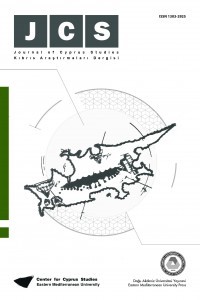Özelleştirmenin İstihdam ve Çalışanların Refahı Üzerindeki Etkisi: Kıbrıs Türk Hava Yolları Örneği
özelleştirme, refah kaybı, Kıbrıs Türk Hava Yolları, ücret fonksiyonu, Kuzey Kıbrıs
Impact of Privatization on Employment and Workers’ Monetary Welfare: Case of Cyprus Turkish Airlines
privatization, welfare loss, Cyprus Turkish Airlines, wage equation, North Cyprus,
___
- Barnett S. (2000). Evidence on the Fiscal and Macroeconomic Impact of Privatization. IMF Working Paper no.13.
- Chong A. & Lopes-de-Silanes F. (2002).
- Privatization and Labor Force Restructuring around the World. World Bank Policy Research Working Paper, no.2884.
- DPÖ (Devlet Planlama Örgütü) (2014). Sosyal ve Ekonomik göstergeler. www.devplan.org. .
- Fretwell D. H. (2004). Mitigating the Social Impact of Privatization and Enterprise Restructuring.
- World Bank Social Protection Discussion Paper Series no.045.
- Geldstein R. N. (1997). Gender Bias and Family Distress: The Privatization Experience in Argentina. Journal of International Affairs, 50: 545-571.
- Gupta S., Schiller C. and Ma H. (1999).
- Privatization, Social Impact, and Social Safety Nets.IMF Working paper WP/99/68 (Washington: International Monetary Fund).
- Güven F. (1984). 74 Öncesi ve Sonrası Kıbrıs Ekonomisi. Yayınlanmamış Yüksek Lisans Tezi. İstanbul Üniversitesi.
- Güven-Lisaniler F. ve Uğural S. (2010). PublicPrivate Wage Determinants and Wage Gap in North Cyprus. EBES 2010 Conference, May 26-28, Istanbul, Turkey.
- Güven-Lisaniler F. ve Eminer F. (2013). Koşullu Yapısal Uyum Programlarının Özelleştirme Sürecindeki Rolü: Kuzey Kıbrıs Örneği. İçinde Neo-liberal Transformation: Dimensions and Consequences. International Syposium Proceedings. Editors: Aksoy S., Saylan G, Altay A., Lekon C., Eminer F. Lefke: Lefke European University : 144-163
- Güven Lisaniler F. (2010). Contemporary Developments in the Labour Market Dynamics of North Cyprus: Exploring Gender Segmentation. In B. N. Ghosh (Ed.), Global Governance, Labour Market Dynamics and Social Change. London: Wisdom House Publications.
- Islam A. & Monsalve C. (2001). Privatization: A Panacea or a Palliative. Michigan University & United Nations Publication.
- İsmail S. (Der.)(2001). TC-KKTC İkili Anlaşma Protokol ve Sözleşmeleri. İstanbul: Aha Yayınları.
- Kikeri S. (1998). Privatization and Labor: What Happens to Workers When Governments Divest? World Bank Technical Paper No. 396, Washington, D.C.: The World Bank.
- MacCuish D. (2003). Water, Land and Labour: The Impacts of Forced Privatization in Vulnerable Communities. Halifax Initiative Coalition Social Justice Committee. Canada: Halifax Initiative Coalition.
- Nellis J. (2006). Privatization—A Summary Assessment. Center for Global Development Working Paper no.87.
- Özelleştirme Yasası (2012). No 24/2012. http:// www.mahkemeler.net.
- Prizzia R. (2005). An International Perspective of Privatization and Women Workers. Journal of International Women’s Studies, 7(1): 55-68.
- Rama M. (2002). The Gender Implications of Public Sector Downsizing: The Reform Program in Vietnam. The World Bank Research Observer, no.17:167-189.
- Ramamurti R. (1999). Why haven’t Developing Countries Privatized Deeper and Faster? World Development, 27 (1): 137-155.
- Sen A. (2004). Özgürlükle Kalkınma. İstanbul: Ayrıntı yayınları 1.Baskı
- ISSN: 1303-2925
- Başlangıç: 2019
- Yayıncı: Doğu Akdeniz Üniversitesi
Finansal Kriz ve Doğalgaz Keşifleri Sonrası Kıbrıs’ta Barış için Görünüm
Kıbrıs: Federal yoksa İki-Devletli Çözüm
Kuzey Kıbrıs’ın Başkenti Lefkoşa’daki Anıtlara Genel Bir Bakış
Devrim Yücel BESİM, Ayer KAŞİF
Özelleştirmenin İstihdam ve Çalışanların Refahı Üzerindeki Etkisi: Kıbrıs Türk Hava Yolları Örneği
